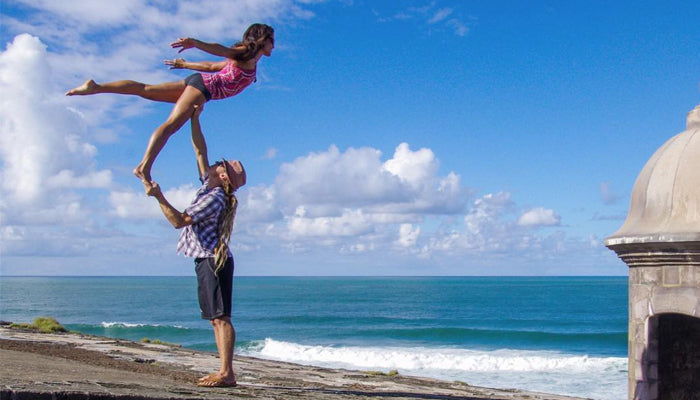New Arrivals
How to build trust with Acro Yoga

image via @poweredbyyoga
Yogis of Instagram are flying high – on the feet of their trusted partner that is. Acro Yoga is gaining major attention because the shapes and sheer strength showcased in this combination of acrobatics and yoga is simply breathtaking. We want in on the fun but first we have to manage our fears - the fear of dropping the flyer and the fear of falling as the flyer. Who’s involved in Acro Yoga?- Flyer – this is the one on top, usually determined by size
- Base – this is the person on the bottom supporting the flyer
- Spotter – this person is usually not seen in the viral Instagram images but their purpose is to ensure safety (super important)
What’s the very first step to Acro Yoga? Is there anything we need to do or know before we start flying?
Other than finding fun, willing, and committed partners, the first thing we think about is safety. We think about safety in three ways:- Environment - Make sure that the area you will be practicing in is free of obstacles and has a huge fall zone. I often see Instagram images of people learning next to tables, fireplaces, or hard ground. You may see experienced practitioners doing this but that's only after they’ve realized their fall zones and they understand that their falling potential is tiny. As a beginner, give yourself enough space to fall and tumble safely.
- Honest Self Assessment - The second aspect of safety involves understanding what you can and cannot do. First, consider your physical limitations. Keep in mind previous injuries and range of motion. Communicate this to your partners and then honor your limitations by skipping particular exercises that may aggravate them or work around them by modifying poses. Next, search for limitations that may come in the form of fears. We also want to communicate those to our partners! Face those fears - with as much love and kindness as you can muster! Eventually you will surpass them. You might be able to work through these assessments on your own... but having a qualified teacher works wonders. There are some things that are simply best learned in person.
- Communication - As you might have noticed by now, communication plays a vital role in partner yoga play. The most important word you need to know is 'Down'. At any time during the practice you ( the base, the flyer, the spotter, or anyone watching) should be able to say down and the ENTIRE group will commit to come down to the ground quickly and safely.

What are 3 physical strengthening exercises we can practice to ready our bodies for balance?
Tadasana for Understanding Stillness
It is important to understand that nature is not still. We are never still. Movement is always present. Standing in Tadasana with your eyes closed is a good example of movement within stillness. Stand up... place your feet together... and close your eyes. Do you feel the stirring action? yeah... Are you freaking out? Some of you will. Some of you will ride those waves like champs. A thing to remember: in Acro we are searching for stability, and that stability comes with a certain degree of movement. The moment you stop searching for absolute stillness is the moment that true play happens.Plank pose for Core
Everything in yoga is a variation of Tadasana. Plank pose is no exception. As an inclined Tadasana, plank pose helps us find our core. Think about pushing the earth away with your arms, of knitting the ribs in and tilting the pelvis up. The tighter you are in this pose the safer and healthier this will be. Notice that I didn't say easier! If I relax into my arms and sag my body it will feel easier at the beginning. However, it will be unsafe for my joints to hold the weight of my limp body. If, instead, I stay tight (which will feel harder at first) my body will grow stronger and healthier and will help me support myself and my partners in the practice.Inversions
Can you do an upside down Tadasana? A lot of the movements in Acro include inversions. The more stable and confident you feel at balancing upside down on your own, the easier it will be to do it on someone else. It's a simple concept.
 Skip to content
Skip to content































